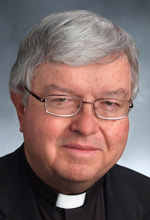Q. I have noticed that the casket of a veteran is no longer draped with an American flag at the funeral Mass. Why not? The service of these men and women helps provide the freedom of worship that we all enjoy. Why does the church no longer honor that? (Daly City, Calif.)
A. The Order of Christian Funerals says in No. 132 that “any national flags or the flags or insignia of associations to which the deceased belonged are to be removed from the coffin at the entrance to the church.”
The guidelines of most dioceses provide that the flag is then replaced by the pall, a large white cloth draped over the coffin as a symbol of the person’s baptism. Surely no disrespect for the flag or the nation of the deceased is intended; instead, the pall represents the fact that all are equal in the sight of God and that, as St. Paul pointed out in his Letter to the Philippians (3:20), our primary citizenship is in heaven.
At the end of the funeral Mass the pall is removed, and the flag can be placed back on the casket before it is carried from the church. Often, at the cemetery, military honors are then accorded to the deceased; a bugler might play “Taps.” Sometimes there is a gun salute and a military honor guard carefully removes the flag from the casket, folds it respectfully and presents it to the next of kin with comforting words from a grateful nation.
The church, of course, is worldwide and must set policy to cover many contingencies. Besides indicating the primacy of the spiritual and the baptism of the deceased, using the pall rather than a national flag for a funeral Mass avoids the awkwardness of a situation where the church might not agree with the moral stance of a particular nation.
In World War II Germany, for example, the use of a Nazi flag during a funeral Mass could have been seen as an endorsement of the Nazi party and the German war effort, when, in fact, the church opposed both.
Q. With the new English translation of the missal it seems, in the priest’s prayer at the consecration, that Jesus has gone from saving “all” to saving “many.” That sounds more like Calvinism than Catholicism. Although, because of free will, not everyone will follow Jesus, didn’t he die to save us all? (Milwaukee, Wis.)
A. For 40 years, until Advent of 2011, we heard the priest say at the consecration of the precious blood, “It will be shed for you and for all so that sins may be forgiven.” Now instead, the priest says that Christ’s blood “will be poured out for you and for many for the forgiveness of sins.”
Because of what we had become used to, the new wording might sound restrictive and selective, as though Jesus did not intend for all to be saved. That, though, would be a misunderstanding.
Clearly, it is central to Christian belief that, as Paul says in 2 Corinthians 5:15, Christ “indeed died for all, so that those who live might no longer live for themselves but for him who for their sake died and was raised.”
What explains the new wording? To start with, it is closer to the normative Latin of the Roman Ritual, which has always said “pro multis,” or “for many,” rather than “pro omnibus,” or “for all.”
The reason why the Latin uses “pro multis” is that this language is more faithful to the Scriptures. Isaiah 53:12 prophesied that the Messiah would take away “the sins of many,” and Jesus himself at the Last Supper said that his blood would be shed for “many”(Mt 26:28 and Mk 14:24).
A pedagogical advantage of the new translation is this: It reminds us that salvation is not completely automatic, imposed in a mechanical way against our will; instead, we must “buy into” the salvation won by Christ by our belief and our behavior.
***
Questions may be sent to Father Kenneth Doyle at askfatherdoyle@gmail.com and 40 Hopewell St., Albany, NY 12208.
PREVIOUS: Pope: God is real, concrete person, not mysterious, intangible mist
NEXT: Does forgiveness have limits? Who has a right to Catholic burial?




Share this story